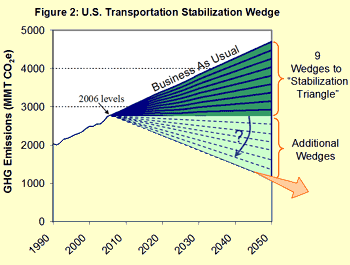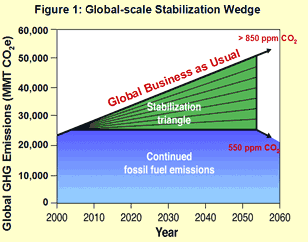An increasingly widespread approach to characterizing greenhouse gas emissions reductions is the so-called Wedges concept introduced by Princeton researchers a few years ago. The concept is relatively straightforward. First, one defines the current path of business-as-usual emissions. We can think of that ramp-like path as defining a stabilization triangle, as shown below.

Based on the past one to two decades, the business-as-usual pathway corresponds to an increase of about 1.5 gigatons per decade—which, if we extrapolate linearly, amounts to about 7 gigatons of carbon emissions over the next 50 years. The stabilization triangle can thus be split into 7 "wedges" that each represent 1 gigaton of carbon over the next 50 years. The first step to stabilizing greenhouse gas concentrations is to freeze annual emissions so that they do not rise any further. To accomplish this, we would need to replace 7 gigaton wedges of projected greenhouse gas emissions that would be required to meet the forecasted business-as-usual global energy requirements over the next 50 years. The individual wedges could be derived from greater energy efficiency, decreased reliance on fossil fuels, new technologies aimed at sequestration of , etc.
Of course, as we have seen from our discussion of stabilization scenarios, simply freezing greenhouse emissions at current levels is not adequate to stabilize concentrations. The emissions must be decreased, eventually to zero, or at least close enough to zero so that they are balanced by the natural rates of uptake of carbon from the ocean and biosphere. So, the wedge approach must be supplemented by an actual decrease in emission rates. In one idealization of the approach, the wedges are used to freeze greenhouse annual emissions for 50 years, after which technological innovations that have been developed over the intervening half century presumably make the problem of fully phasing out fossil fuel-based energy more tractable, and emissions can be reduced over the subsequent 50 years as necessary to avoid breaching, e.g., twice pre-industrial levels. Alternatively, more additional wedges, beyond the original 7, can be used, to not only freeze annual emissions at current levels during the next 50 years, but instead, bring them down.
The wedge concept can be generalized beyond the global stabilization problem. For example, the U.S. EPA has introduced wedge-based plan for reducing emissions in the U.S. transportation sector as a means of mitigating this important current contribution to U.S. greenhouse gas emissions.

The Wedge Concept is an increasingly popular way to go about achieving the required greenhouse gas emissions in the decades ahead, by thinking about each of the individual mitigation approaches that might buy us a wedge, or some fraction of a wedge, of reductions. It is a way to think about how to take a seemingly intractable problem and break it up into many smaller, potentially tractable problems which collectively can help civilization achieve the daunting emissions reductions necessary for avoiding potentially dangerous climate change.

